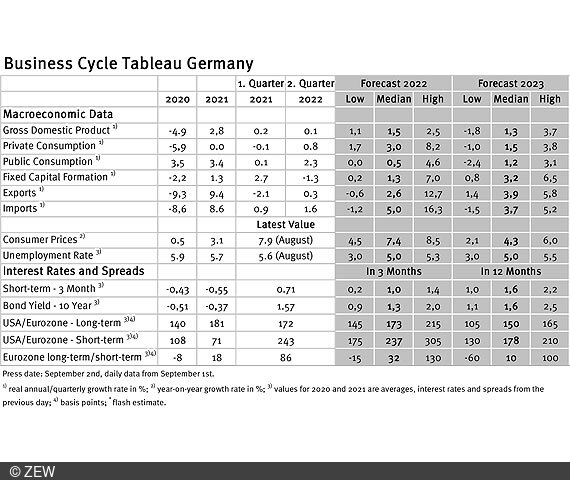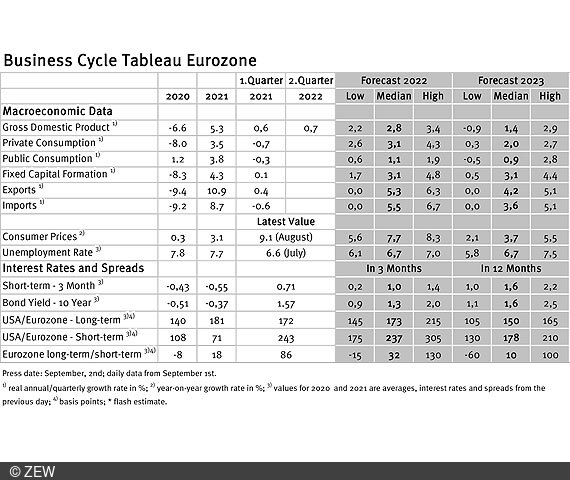High Uncertainty About Future Economic Development
Business Cycle Tableaus by ZEW and Börsen-ZeitungForecasts of Economic Experts Vary Greatly
Economic experts are revising their economic forecasts for Germany significantly downwards, while inflation forecasts are rising further and uncertainty about the future development of the economy is high. This is the result of the business cycle tableaus by ZEW Mannheim and the German daily newspaper, Börsen-Zeitung.
In the second quarter, the revised values for the real gross domestic product (GDP) in Germany show a slight growth of 0.1 per cent compared to the previous quarter, following initial reports of stagnating GDP. Nevertheless, the outlook for the third and fourth quarters of 2022 as well as for 2023 is fairly gloomy. This is clearly reflected in the decline in economic forecasts for this year and the next.
Uncertainty causes forecasts to vary considerably
For 2022, the median GDP forecast drops from 1.7 to 1.5 per cent. For next year, the decline is even more pronounced, with a median forecast of only 1.3 per cent, compared to 2.1 per cent in the previous month. Most strikingly pessimistic is the real GDP forecast for 2023 of -1.8 per cent, compared to minus one per cent the previous month. The range of individual forecasts for next year has thus widened significantly, from -1.0 to 3.8 per cent in the previous month to currently -1.8 to 3.7 per cent. This can be interpreted as a sign of great uncertainty among forecasters. The forecasts for next year vary between a significant recession in the German economy and relatively strong growth – the forecasts could not be more different.
High rate of price increase expected
The inflation forecasts for both years have been dramatically increased. For 2022, the economic experts now expect a median value of 7.4 per cent for the average inflation rate. This is a rise of 0.4 percentage points compared to the forecasts that were available in August. For 2023, the median forecast climbs from 3.7 to now 4.3 per cent. Although the timing of the forecasts has not changed – with inflation peaking towards the end of 2022 and then falling sharply in 2023 – the rise for 2023 shows that the rate of price increases is expected to remain high. With a range of forecasts from 2.1 to 6.0 per cent, the median value of 4.3 per cent shows that the European Central Bank is likely to face some very difficult months ahead and that so far there is no apparent reason not to raise interest rates noticeably further. The experts also expect (at the median) a further increase in three-month interest rates from the current 0.71 per cent to 1.0 per cent this year and to 1.6 per cent in 2023.
Business cycle tableaus by ZEW and Börsen-Zeitung
In cooperation with Börsen-Zeitung, ZEW has been publishing monthly business cycle tableaus for Germany and the eurozone with economic key figures and forecasts since 2013. Numerous banks and institutes publish reports on the current and prospective economic situation at different intervals. The information relevant for the tableau is filtered out of these publications to compute a median, minimum and maximum of the available forecasts for the current and subsequent year.
The monthly tableaus show current GDP forecasts, its main components, consumer prices, industrial production, unemployment rate, short- and long-term interest rates, and interest rate spreads. The focus of the tableaus lies on national business cycle reports, which are complemented with forecasts from international banks and institutes. The tableau for the eurozone is enhanced by data from European banks and institutes.

